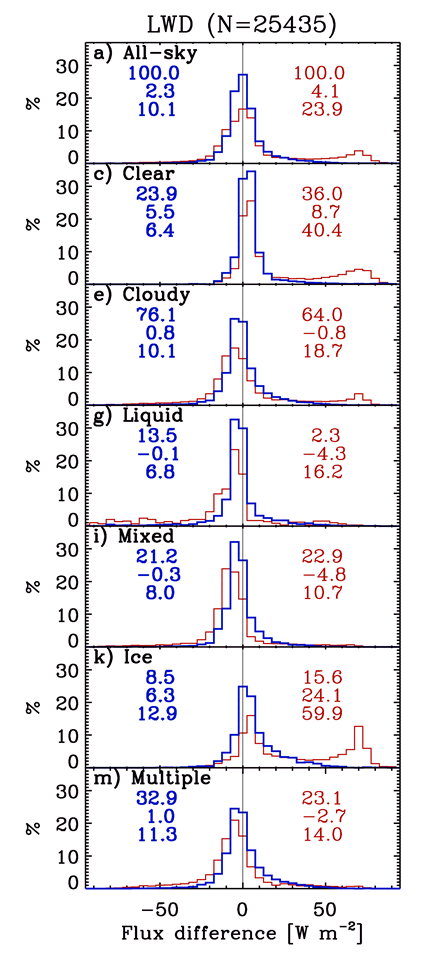Liquid water the key to arctic cloud radiative closure
Submitter:
Shupe, Matthew — University of Colorado
Area of research:
Cloud Distributions/Characterizations
Journal Reference:
Science
Consistent with our growing understanding of Arctic liquid water clouds, it is not surprising that proper identification and characterization of cloud liquid water is important for accurately representing Arctic radiative fluxes. This conclusion was one of the primary findings resulting from the development and evaluation of a comprehensive cloud retrieval suite, called ShupeTurner, which was applied to multisensor observations at the ARM North Slope of Alaska (NSA) site. This retrieval approach was evaluated using radiative closure analyses and compared with the baseline cloud microphysics product, MICROBASE, produced operationally by ARM to demonstrate the value and influence of cloud phase for proper characterization of cloud properties.
Impact
This manuscript introduces the ShupeTurner comprehensive retrieval suite for characterizing vertical profiles of cloud liquid and ice microphysical properties in all conditions from operational cloud radar, depolarization lidar, microwave radiometer, atmospheric emitted radiance interferometer, and radiosonde measurements. The suite was built around a cloud phase-type classification scheme that guides the subsequent application of conditional cloud retrievals for liquid and ice hydrometeor populations that have been developed with DOE support over the past decade. The system was specifically designed for application in Arctic conditions, where deep convection does not occur, and has been applied to multiple Arctic sites. To illustrate the retrieval suite, it was applied to two years of observations at the NSA site. From the two-year dataset, we found that in Barrow, cloud ice and liquid water each occur in the vertical column about 57 percent of the time, sometimes together. Liquid water was found to occur at least 25 percent of the time in all months, even in the particularly cold and dry winter. While typically at lower altitudes, liquid water can occur up to heights of 8 km in summer. When clouds do occur, there was typically more condensed liquid mass in the atmosphere than ice mass, with a diminishing difference in winter.
A radiative closure approach is used to evaluate the quality of this cloud retrieval product wherein the retrieved microphysics are incorporated into atmospheric radiative transfer calculations to produce surface and top-of-atmosphere broadband longwave and shortwave fluxes that are subsequently compared to ground- and satellite-based measurements. Clear sky closure is not perfect, demonstrating some insufficiencies in the radiative transfer approach likely related to the exclusion of aerosol properties and the proximity of Barrow to the Alaskan coastline. With clouds present, radiative closure biases are typically reduced relative to clear skies, demonstrating the general success of the cloud retrieval. The variability of derived cloudy sky fluxes relative to measurements is, however, somewhat larger than that for the equivalent clear sky subset due to the general complexities, variability, and heterogeneity of clouds.
Summary
Using this same radiative closure approach, ShupeTurner microphysics results were compared to those from the MICROBASE operational product to reveal the impact of key retrieval improvements. Specifically, when the two retrievals disagreed on the presence of liquid water in the atmosphere, the ShupeTurner radiative closure metrics were substantially better than the MICROBASE closure metrics. This result is illustrated using surface longwave radiative flux closure in Figure 1, where MICROBASE results show a substantial second mode with radiative residuals on the order of 50-70 W/m2, demonstrating the potential adverse impacts of phase classification based on temperature alone. ShupeTurner relies on a more sophisticated phase classification that combines phase-specific signatures from multiple sensors and consequently has little indication of systematic phase classification issues. Additionally, ShupeTurner employees an enhanced liquid water path retrieval that combines microwave and infrared measurements, while MICROBASE uses only microwave measurements. The combination of these factors, both identification and quantification of liquid water, resulted in substantially better radiative closure. This result suggested an overall improved representation of clouds using the ShupeTurner approach and highlighted the important role cloud liquid water plays for Arctic radiation budgets.


